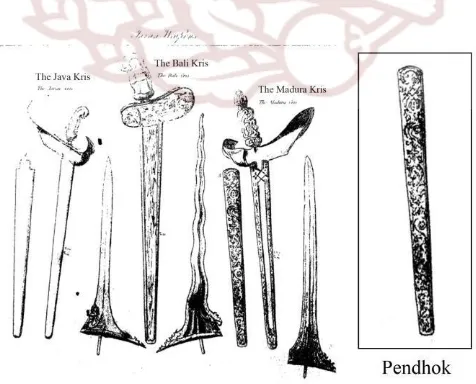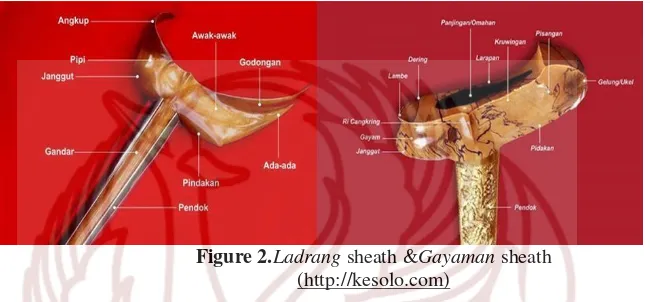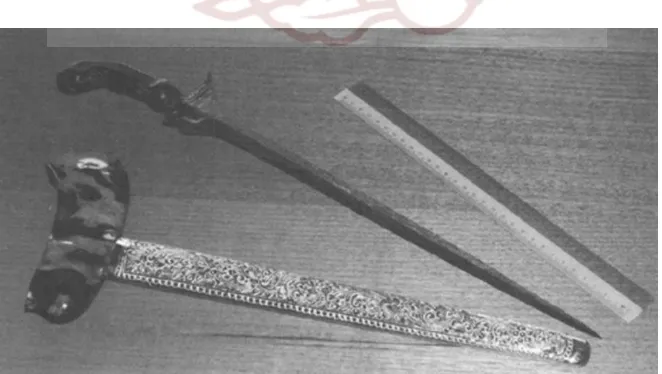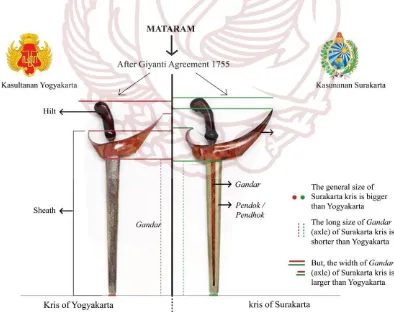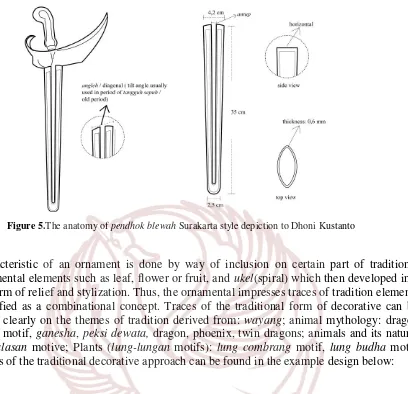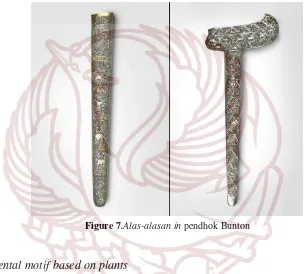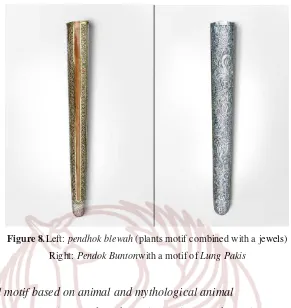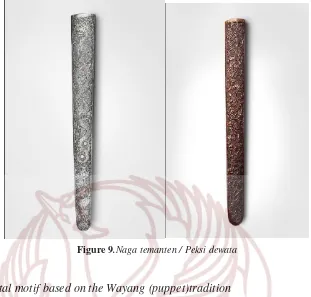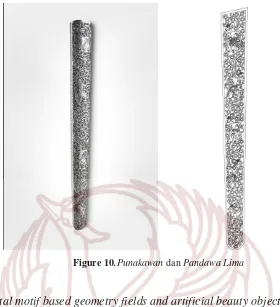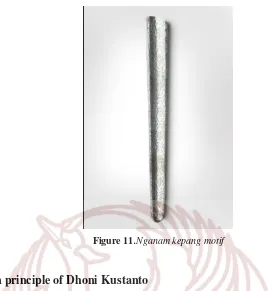THE PENDHOK STYLE OFSURAKARTA KRIS
A CASE STUDY OF DHONI KUSTANTO AS PENDHOKARTIST OF 90S MRANGGI GENERATIONS
Guntur*
The Batik Department, The Indonesian Institute of Arts, Surakarta gunturisi@yahoo.co.id
Abstract
Kris(keris) is a kind of Javanese dagger with its main parts: blade, hilt, sheath, and pendhok.The pendhok is a protective part of the sheath, usually made of various metals such as silver, bronze, copper, brass, and even gold. Krisof tangguh nom (young period) which (warangka), especially ladrang and gayaman, with the hilt of tunggak semi (spring stump). The pendhok form follows the sheath style, and its ornaments mostly signify an adopted art of pre-Islam: Hindu – Budha. As Majapahit diminishes and Islam arose, the kris then shaped in the palace traditions in the hegemony of Islam Kejawen and the king is in the center. Kris culture arranged as a form of synthesis between Old Java of Majapahit with the New Java of Islam Pesisiran (seashore) in the era of Islamic Mataram by Sultan Agung. During the colonialism, the conflict over Mataram authority hadchangedJava, alsomade Surakarta and its kris form producedin different identities through the kris culture and customary fashion in the Palace and then rooted in the Surakarta folk by the mranggi in the outside of Palace.
Keywords: pendhok, Mranggi, Ornament, Kris, Folkart, Identity, Surakarta, Java
1. Introduction
Indonesian kris becomes the world's intangible cultural heritage by UNESCO in the 2000s. This achievement based on the historical roots of kris culture, one of them is in Java. The kris has long been part of Javanese culture, it is shown in world explorers text of Ma Huan.
He visited Java (Majapahit, Hindu‟s Kingdom, East Java) in 1433. He said that all menin
Majapahit, from the king to commoners, from little boys of three years to old men, slipped a pu-la-t’ou (dagger) in their belts, they all have these knives which are all made of steel with
most intricate patterns drawn in very delicate lines, for the handles they use gold or rhino‟s horn or elephants‟ teeth, carved with a depiction of human or demon, the carving works are
who had embraced characteristic patterns of Javaneseness (Ricklefs 2006:20). They have
used gilded kris (Ricklefs 2013:31).The kris is part of aneveryday life of men‟s customin
Java, at least in the Boomgaard text, all Javanese men wore a kris up until World War II (Boomgaard 2013:116).
During the interest of an „ethnologist‟ which described Java, the Surakartakris was shown in The History of Java, this subject then „continued‟ by Isaäc Groneman in The Javanese Kris.Raffles narrated the men in Javanese dress as follows “his kris should have the sheath of the sátrian (knight) fashion, and the handle should be that of túng’gáksmi(tunggak semior
spring stump)”(Raffles 1817:95). What is Raffles signifying was the kris culture in the
Palace.While Groneman wrote about the forging of blades and other parts of the kris for example pendhok.The custom of knight in Surakarta palace has been „fixed‟ its fashion rule with the kris, especiallythekris handle of tunggak semi. This style is conceptualized by PB III (Pakubowono III) when he came to power in 1749 – 1788with the aim to differentiate with Kasunanan Kartasura (1680-1745) which happens in the conflict of powers over the authority of Mataram.
Around the 1800s the important manufacture of cutlery is the kris, a pándi employed to manufacture a good kris blade, the manufacture of sheaths or scabbards (sarong) for the kris constitute an exclusive profession, and the manufacturers are called tukang meránggi, or mergongso (Raffles 1817:173). In Raffles's description, the kris and some other specialist in craftsmanship are written in terms of industry. Those specialist are túkang-tambógo (coppersmith), tukáng-mas (goldsmith), and a jeweler. Those professions are connected to the craftsmanship of pendhok, and to be surethe tukang mranggi has to connect with those specialists of precious metal and stones to decorate the sheath. The assembly specialists being said by Timbul Haryono (historian) then affirmed by Basuki Teguh Yuwono (kris master and scholar) called penggaluh (a jeweler) (Wijayatno & Sudrajat 2011:162). But, the term of penggaluhseemsto have the difficulties to its references in the modern literature, whereas until now, the mranggi mostly was still known as the sheath maker and also the pendhok.The kris has been a product of traditional industry, the diversification of related profession spread in a market, and the form is manufactured to be identical to the origin of the kingdoms.
Figure 1. The type of kris, and the pendhok
(Picture suplement in The History of Javaafter page 296)
its image is related to the Madura kris (Raffles 1817:296-...). The years when Raffles doing his research there weresome type of pendhokthat already cultivated, and in certain condition was prohibited by PB IV (Pakubuwana IV) in Surakarta i.e. pendhok parijata (swollen rice), pendhok tatahan sawat, and kemalon abang. The kris which using the handle of tunggak semi (spring stump) were may be used by the knights (Margana 2005: 289, 292). The sheath of kris that was known at that time till today is gayaman and ladrang. Warangkaladrang commonly used at official ceremonies to complement the customary clothing, is a tribute, both ends curved like an ancient boat. While the gayaman as a complement to dress in unofficial events, simple form, widely used during the war for ease of use of kris, and the function of the warangka is as a shield, deflector, and to shovel(Wibawa 2008:42).
Figure 2.Ladrang sheath &Gayaman sheath
(http://kesolo.com)
The History of Java is the attempt of Raffles to display the island of Java and its structure for
the sake of knowledge in colonialism, and while Groneman‟s was doing an involved
research to built and shows the Javanese kris culture and its part. Both are in different intentions in writing the Java, but their works becomes the founding text of seeing the "Java" in objects culture. The Raffles texts gave the stepping stone in discussing the pendhok that hadn't be explained but giving a guide in which mranggi's social categorical and descriptive information. While Groneman's was opposite, he described the category of pendhok but lack in the description of mranggi's social culture. These texts are different to the text in the stories of Babads (history-chronicle) which written and mixed with legends, myth, in the will of the local rulers.
2.Literature Review
The javanism of Surakarta in kris culture
In the context of kris culture, the Surakarta kingdom is rooted in Islamic Mataram with its patronage power of being Javanese to its folks. Majapahit glory inspired Sultan Agung (1613-1646) to prove Majapahit traditions is not the enemy, but the root of Mataram's existence. Muslim rulers are closer to the tradition of Javanese Majapahit than to Islamic traditions in the Arabian Peninsula or even the coast of Sumatra(Vlekke 2008: xvii-xviii). The Hinduand Buddhist ideashave formedthe Javanese, the process called “Javanization” which refers to thevarious Indian cultures that enteredJava, then developed in its own literary (Kawi) and religious culture, the Majapahit kingdom considered asstrong synthesis of Hindu-Javanese culture (Banerji 1989:589; Wiryomartono 2016:32; Ricklefs 2013:29). This
old civilization or in language domain is termed as „Old Javanese‟ are refers to the pre- Muslim era of Javanese history (Uhlenbeck 1964:108). The traditions which influenced by
„old javanese‟ it has a large number of Sanskrit loan words and it has a large number of Sanskrit loan words (Zoetmulder 1974:8; Auroux 2000:187)
The appropriate word to describe the practices of Javanization is syncretism. As Majapahit diminishes, and the strengthening of Islam emerges through the Demak kingdom resulting in a synthesis between Hindu-Javanese culture and Islamic culture (Sachari 2007:33). M.C.
Ricklefs said the synthesis in which Sultan Agung done is the “mystic synthesis” that united
the Javanese and Muslim (Ricklefs 2013:32). It is considered to do with ethics and aesthetics. The patronage of of syncretism never broken up either in pre-colonial or in the colonial Java, mainly in Era PB III – PB IV. Surakarta and its literary culture have retained a special significance as the locus classicus of an ancient literature which has resisted
Islamization...and being said by Gericke as “the mecca of the Javanese language”(Hooker
1988:134). The syncretism continues when Islam came to power in Surakarta palace. Some traditions i.e. slametan raja wedda and maesa lawung, according to the customary law of Majapahit were passed down from Demak (the first Islamic kingdom in Java) into Mataram- Kartasura in era of PB II, 1748 (Headly 2004:292-294; Headly 1979:49-57). The Hinduand Buddhist religion is not accepted as the official religious culture of the kingdom, but its traditions and customs, especially kris, continues as part of tradition of the previous palace, the simplest words: Surakarta is inherit the form of Mataram-Kartasura.
Figure 3.The Kiai Wali, 15th or 16th century made by Sunan Giri,the handle of Surakarta from 19th century
The empu/mpu, and mranggiis a traditional artists in the form of patronage. Theartists have been part of the state bureaucrafts, in palace, the relationship between the artists and the clients, especially the kings is about the patronage of power (Wiryomartono 2016:9). The patronage of power has to do with ethics and aesthetic in how to become a Javanese Muslim which had begun by Sultan Agung, then inherited by his descendant. Yasadipura II, the poet
who worked during the reign of Pakubuwana IV repeatedly advises that Java‟s adat(Hindu- Javanese tradition) should be maintained, and priyayi should not invent their own adat (Riddell & Street 1997:270).Kejawen identified as syncretic, an other form of Javanese- Islam which differentiated with santri traditions (Mulder 2005:21; Janowski & Kerlogue 2007:24-33; Cederroth 1991:18; Hooker 1988:63).
Especially in PB IV era, the „Javanese-ness„ then had not identified as Hindu-Javanese ideas but commonly termed as kejawèn or Javanism which informs ethics, custom and style, used to identify the Javanese who qualify as santri (Islamic pupil in pesantren) but discussing life in the perspective of wayang (shadow play/puppet) (Mulder 2005:16). Since Islamic influence was in effect in Javanese societies, the literacy role and function of the ancient priest (mpu, empu, pandita) which known in Hindu-BudhistJavanese literacy had been transformed and entrusted to the puppet master (dhalang) (Wiryomartono 2016:6). At the time of Dutch colonialism entered the life of Java, the Surakarta arts, and religious culture is ruled by the Mataram priyayi (rulling class). Facing the colonialism, PB IV is more attached to the potential of Islam as a social movement. The literary research on Serat Wulang Reh from PB IV's work shown the Surakarta literature was derived into two kinds of Islam: Islam santri and Islam kejawen. If Islam santri literature develops in pesantren, surau, contains Islamic syariat, whereas Islam kejawenmore uses Javanese language than Arabic letter, for example that is primbon, its contents are developed in Javanese tradition (Ardani 1999). PB IV is known was influenced by ulama, and made changes of fashion rule: changing the clothes of Dutch-style warriors with Javanese clothes, and abdi dalem (court retainer) who faced the king were required to dress santri (Katno 2015). Serat Wulang Reh is not much use of arkhaik (ancient) Javanese.While PB IV was regulated the uses of a certain pendhok in particular social level in Palace, at the same time he wanted to remind and introduce Islam through culture.
In particular description, the Surakarta inJavanese Literature in Surakarta Manuscripts: Introduction and manuscripts was founded by Pakubuwana II in 1745, nearly 250 years from its establishment, Surakarta for many Javanese is represent the authenticity of Javanese (high) culture. Privileged in this representation is the imagined cultural preserves of
Surakarta‟s two courts: the Karaton Surakarta and the Mangkunegaran (Florida 1993:11). During the colonialization, the Westernization occurring in many sectors, and kris is a resistance in kraton fashion customary (Lombard 1990:107-112). Between the two “Java”s exemplified by the Kraton and Mangkunegaran that produced truly durable fabrications of
“Javanese” style, just as the Mangkunagaran Palace had its own pleasure retreats and ritual kinks, the Kraton Surakarta remained the original post-Kartasura trace of cultural authenticity (Pemberton 1994: 112).
The aesthetic of pendhok
have magical powers, but it is conceivable that in Java, and magical ritual context is more pronounced because of the scarcity of the metal (Lombard 1990:131-132).
The formation of pendhok mainly associated with Surakarta style, it has connected with the form of Surakarta kris which conceptualized by PB III to differentiate with Kasunanan Kartasura. As Pemberton said, seemingly the aesthetic of pendhok and Surakarta kris is remained the original post-Kartasura trace but with the authenticity of PB III since he want to differentiate with Kasunanan Kartasura. In the manufacturing process, a pendhokis made following the sheath in which follows the form of the kris. Kris style is compacted in a tangguh (period), ahistorical timeof kris which centered on the pamor and the myths of its metallurgy. An aesthetic of pamor lies on the blade that is created through the process of forging, the 'chunk' of metal are folded many times so that it becomes flat, solid, hard, and strong. The blade becomes a kris if it unify with others parts, i.e sheath. The sheath usually uses wood and need to be protected with metal, called the pendhok. A krismay have up to three scabbards used for the same blade for different occasions of formal dress (Ellis 2009:471). Pamor is not a form of an ornament, but it is considered to have its own power (Brown & Hutton 2011:112). In other words, pendhok is signifying the power of ornament, its beautify, or harmonicity in visual form.
pendhok could be categorized by materials, techniques, types and forms, as well as functions. Judging from the materials which are used, pendhokis created using several type of metals, such as brass, silver, and even gold ,also anothermetal, ie swåså. The mixture metals is resembled a gold (Groneman, 1910). Based on form, there are some pendhok, i.e. pendhok cantaloupe, slorok, bunton, topengan,andkemalon (Groneman 1910, Haryoguritno 2005). Based on the manufacturing technique, pendhokis categorized into pendhok krawangan, pendhok tretes, pendhok cukitan, and pendhok tinatah. According to Harsrinuksmo And Lumintu pendhok kris have to do with ethics. There are pendhoks which prohibited to the 'ordinary people and is otherwise only be worn by nobility, ie. pendhok kemalonwith white background must not be used by folks. pendhok Tretes with the specific sheath only worn by the king (Harsrinuksmo And Lumintu, 1988).
Although the discussion of ornaments pendhok very limited, but some of that may be mentioned include (Raffles 1817), Groneman (1910), Harsrinuksmo and Lumintu (1988), Harsrinuksmo (2004), Haryoguritno (2005), and Yunus (2012). According to Groneman, ornaments in pendhok just as motifs in batik. Some motifs include sembagen huk, kuma drawan, semen ageng, semen manyura, semen jlengut, parangan, cemara sewu, ombak banyu, unthuk-unthuk, gringsing, jlengut, saton, and lunglungan. There are pendhok with a special motif semen jlengut used only by kings (Groneman 1910) or the sunggingan sheath with motif of alas-alasan in white background only be worn by the king (Harsrinuksmo and Lumintu 1988). While the royalty at level of regents, tumenggung, and riya can wear pendhok with unthuk-unthuk motif (Groneman, 1910).
kraton. For pendhok cantaloupe, motives are often depicted include:lung kanthet, lung anggur, lung kertas, lung combrang, lung wajik, lung budha, lung kenanga ginubah, lung modang, and lung plisiran (Yunus 2012). Ornamental motifs such as flora, plants or in the Java language is often called the lung-lungan is a common motive which applied in pendhok.
Isaäc Groneman in Javaner Der Der Kris (1910) definespendhok as a sleeve that serves as a protective glove, especially a very valuable glove. Haryono Haryoguritno in Java Keris between Mysticism and Reason (2005) defines pendhok as a complement or a metal covering of kris sheath: kandelan (thickness). In the Encyclopedia of Javanese culture, pendhok serves as a protective or coating axle, which is part of kris sheaths made of wood. However, its protective function then turns into a luxury. The simplest pendhokis usually made of brass or copper, but that luxury is made of silver or gold set with diamonds (Purwadi 2005: 381). The use of the material aspects, quality results, and the manufacturing process determine the economicexchange of pendhok.
3. Methodology
Considering the things above, then a case study on the masters of pendhok becomes important to represent an artistic process of traditional art of kris in the current time. Among the limited number of masters, there is Dhoni Kustanto who in the lineage of tukang mranggi. He is consistent, devoted itself solely to the world of the kris in Surakarta. Although relatively young, Kustanto has proved himself: productive, creative, and innovative, with high-quality handwork. He is not only capable of producing classic pendhok as a legacy of the previous generation, but also creates a new motif. His various creations are filled private collections in the collector space inside and outside the country. The commitment in the world of the kris is also realized by dividing the result of the design to other pendhok practitioners. Research on Dhoni Kustanto is to get a general overview of the process of making pendhok, style of Surakarta, the types and forms.
The research took Surakarta as the location because its status as the cultural center of Java where the existence of the kris practitioners becomes one of the pillars of the traditional culture. Surakarta is also an area where a handful masters of pendhok dedicates them self in the preservation and continuity of the kris world. As we can see in figure 1, Surakarta is a central part of the Javanese culture legacy where the traditional arts have been created, preserved and developed. The logic used here is the kris culture permeated from the center to the periphery, and not calculate the Surakarta style which rooted in the periphery.
This study uses a qualitative exploratory approach to a single case study investigation on one slice of an 80s generation master of pendhok. The study focused on the production process which done in house as well as a workshop place to get the equipment and materials; making process; the visual documentation in the form of photos, image selection / design to get work performance. Data also collected through the study of literature and documentation. The data here includes two things: written and visual material. Written material is information, ideas, and opinions that have been published either in journals and books, online publications, as well as material written in paper form. Visual data, including visual images and photos, both of which exist in various publications as well as pictures were taken by investigators. Furthermore, the data were analyzed with the written and visual exploration approach.
formation of pendhok of Surakarta style in various context, the analysis then directed to the túkang-weróngko (kris-sheath maker), túkang-tambógo (coppersmith), kemasán or pande mas (goldsmith) (Raffles 1817:164; Sheng-Lan1970:88; Haryono 1991-1992:62-63; Subroto & Pinardi 1993:210). The scope of pendhok profession spread in all most districts in Java. The style of Surakarta sheath has been spread into the western part of Central Java such as Tegal, Sumenep, Banyumas, Cilacap, Purbalingga, Banjarnegara, Wonosobo and Kebumen as relics of the Sultanate of Mataram (Surakarta and Yogyakarta), and also identified by the existence of mranggi profession. It was happened in the era of Islamic Mataram, especially after Giyanti Agreement in 1755 divided the Islamic Mataram kingdom into two parts: the Sultanate of Yogyakarta and Kasunanan of Surakarta.
The mranggi has been known as the sheath maker of kris, this proffesion is exist in era of Brawijaya, Majapahit (Sastronaryatmo 1986:105). After Majapahit receded, Demak and successor of pasisir (seashore) polities adopted many of the courtly traditions of Majapahit, with master craftsmen brought over from East Java to work on court buildings and mosques.Although Islamic law was used extensively, it appears to have existed alongside older Hindu-Javanese adat. The Hindu-Javanese traditions becomes a customary law which needs to be renegotiated.In cultural matters, the kris were taken over and developed by pasisir rulers and the locally revered „apostles of Islam (wali sanga) (Lieberman ed. 1999:270). The presence of Mataram after the fall of the Sultanate of Demak (1546), precisely in the era of Sultan Agung (1613-46) created a synthesis between the old Javanese Majapahit and the new Java Muslim coastal cities. Artisans, The metalworkers known as the Kalang work for Sultan Agung (Lieberman ed.1999:273). In the Later Mataram, there is a village naming system based on the people's profession. In Kotagede when the royal court was established, Mranggen village got its name from mranggi or sheath making (Nakamura 2012:40). The skills is inherited from their ancestors, the kalang or “Wong kalang”. The Kalang People were originally war captives brought back by Sultan Agung. Conflicts and civil war over Mataram authorities cause the location of the palace moves along the lineage conflict up to Kartasura, and then Surakarta.
Suryono said that the king's privileges as the successor of the kings of Java is to have a kris masters and tangguh (the style), which has only the King of Surakarta Kasunanan, while Mangkunegaran does not have a tangguhprivilege because only at the level ofAdipati(Duke)Anom (Suryono 2012). What Suryono said corroborates Pemberton‟s
opinion that the Kraton Surakarta remains the genuine trace of Kartasura‟s cultural
authenticity, thus identified as post-Kartasura. Although the form is rooted in the Kasunanan Kartasura (1680-1745), but the distinction which affirming the style of Surakarta is believed to have begun in the leadership of Sunan Pakubuwono III (1749-88). The legitimation of kingdom identity through kris form from the Kartasura to Surakarta has shown that the hegemony of palace as ruling class then accepted by the empu, pandi, mranggi, and folks.
The Giyanti's Agreement 1755 in PB III formally had dividing the Islamic Mataram kingdom into two parts: the Sultanate of Yogyakarta and Kasunanan of Surakarta.It was the time when a kris and its equipment i.e. pendhok were regulated to identify the difference between Surakarta and Yogyakarta. The style of Surakarta kris is recognized from the shape of the sheath and hilt, especially ladrang and gayaman, with hilt of nunggak semi (Yuwono 2012), this handles marked with a small carving called Cecekan or Patra. The sheath ofladrang is worn to attend a ceremony, party, while the gayaman worn while performing a task. If the Surakarta kris has smaller body shape compare to Kartasura, but since the Palihan Nagari (Agreement of Giyanti 1755) Surakarta kris has known bigger than kris Yogyakarta. The form of Surakarta kris has known by mranggi in Surakarta is form in which can distinct with the Yogyakarta, and then becomes a model for the pendhok.
The ornament style of pendhok by Dhoni Kustanto's work
During the Islamic period in Java, an traditional art shown the adoption of the pre-Islamic form, sometimes after further process and extreme stilization as seen in the art making of wayang and other ornamental motif applied in the Kraton and mosque. The advent of Islam does not really eradicate figural representation but there is an attempted to press it into abstracts (Wahby 2007). Cultural ornament from Hindu-Buddhism of Majapahit period temples displaying animal and bird figures, such as geese, peacocks, elephants, and horses. Leaves are widely used, and in many cases, the style tends to turn into curls. Flower is executed in naturalistic form with stems and leaves (Wahby 2007). Seeing the way of stylization, Hinduistic flora seems to be a common form of ornaments. Some motifs that are identical with Hindu and Buddhist are lotus, and chakra (Kossak and Watts 2001:25) doesn't exist in Old Javanization, thus logically 'absent' in the tradition of ornament in Islamic Mataram till ornament of Surakarta pendhok. The figural motif of a mythological animal from Hinduism such as ganesha and garudaoften appears in the ornament. Those animals are symbol and vehicle in Hinduism imagery (Miyazaki 1988:148). Apparently, the art of ornamentation in pendhok still takes the flora and fauna of Hinduism, but the image of God or the divine figure in the spirit of Hinduism were 'removed' or the values has reformed in the figural of wayang based on Hindu epics, and a mythical symbol. Others animal figures also found such as kidang (deer), macan (tiger), etc. This mode of ornamentation has become a tradition in mranggi visual literacy.
Figure 5.The anatomy of pendhok blewah Surakarta style depiction to Dhoni Kustanto
Characteristic of an ornament is done by way of inclusion on certain part of traditional ornamental elements such as leaf, flower or fruit, and ukel(spiral) which then developed into the form of relief and stylization. Thus, the ornamental impresses traces of tradition elements identified as a combinational concept. Traces of the traditional form of decorative can be found clearly on the themes of tradition derived from: wayang; animal mythology: dragon king's motif, ganesha, peksi dewata, dragon, phoenix, twin dragons; animals and its nature: alas-alasan motive; Plants (lung-lungan motifs): lung combrang motif, lung budha motif. Traces of the traditional decorative approach can be found in the example design below:
Figure 6. Redesign the pictures of ornamental traditions
In general, the theme of the motif worked by Dhoni Kustanto does not have specificity. Its motifs come from: alas (forest), plants, animals, animal mythology, puppetry, geometry, decorating fields, and the beauty of artificial objects.
(a). An ornamental motif based on alas (forest)
on the ecosystem from the bottom to up, namely: water, land, and air. The principal depicted on forest life in which there are various examples of natural animals: fish, crocodiles, tiger, deer, elephant, rhinoceros, bulls, dragon, birds, winged dog, jatayu, and winged lion. The birds of Jatayu or garuda is a mythological animals that can be found in the source of the puppet story. If we look at the alas-alasan in Javanese political economy, the forest becomes the embryo of the Javanese court, that is why the base becomes an aesthetic inspiration and the expression can be found in various artifacts with various media variations. Forest has become an important reality in the life of Javanese society. Forest not only provides the physical potential of natural resources, but also the spiritual power of life. Forest as a whole becomes an important part of the religious, spiritual and ritual beliefs of the community (Guntur 2015:38)
Figure 7.Alas-alasan in pendhok Bunton
(b). An ornamental motif based on plants
Figure 8.Left: pendhok blewah (plants motif combined with a jewels)
Right: Pendok Buntonwith a motif of Lung Pakis
(c).An ornamental motif based on animal and mythological animal
Figure 9.Naga temanten / Peksi dewata
(d). An ornamental motif based on the Wayang (puppet)tradition
"Wayang tells the various acts of the gods and the Hindu heroes which are considered to take place in Djawa ... The Keraton of Java is essentially the treasury of the ancient Hindu periods, called the Javanese" buddha Buda "(Prijohutomo, 1953).
Figure 10.Punakawan dan Pandawa Lima
(e).An ornamental motif based geometry fields and artificial beauty objects
Figure 11.Nganam kepang motif
The decoration principle of Dhoni Kustanto
In the 80s most of the techniques used to realize ornaments pendhokare using cukitan technique, and wudulan (typical of Yogyakarta). The usual staining technique is practiced, which is chromium of gold, silver, copper and silih asih (two colors with unified become in compositions of alternating). In drawing ornaments, Kustanto always starts from the bottom (base) to the top (tip) of pendhok. The size of the ornamental elements of plants, animals, and others usually begins with a small size and gradually getting bigger till reach to the tip of pendhok,or to cover the widened field of space is done by adding the number of elements. The tools used are pencil, paper, drawing pens of various sizes.
The pattern of lung-lungan became the general basis in the work of ornaments, either as main or additional ornaments, the main or the sweetener part. Rhythm of lung-lungan becomes the "center" in organizing various combinational elements. Merging of ornamental traditions, such as leaves, flowers or fruit, and ukel with the form of development creations for later connected to the stem of lung-lungan (the spiraled vines). The rhythm of lungis a movement from the left and to the right or vice versa that leads to the top, following the logic of plant growth. The shape of the lung-lunganrefers to the ornamental decorations arranged continuously create the rhythm of alternating (SP.Gustami 2007:120). This lung- lungan pattern is used primarily in an ornamental plant motif which derived as the main visual subject, and on the other motifs plants have placed as backgrounds that support the motion rhythm of the main elements in ornaments. There are artistic principles used in making ornaments. Some principles of an arrangement of elements obtained from observations on ornaments and ornament design works of Dhoni Kustanto are as follows:
1.The principle of repetition
element's shape, size, direction, and position by using the opposite technique (mirroring), scaling the size, and adding elements.
2.Reproduced motif as a re-creation of technique, from cukitan to relief
The cukitan technique commonly used as a technique of an embodiment of ornaments on pendhok. The technique works in the way of reducing the material by means of carving up the surface, pointing the instrument movement that is pressed to the metal and then moved upwards in an effort to take the surface of the material, so the surface is reduced. The level of cukitan technique which deepened then lead to the process the relief techniques on pendhok. The relief techniques reached the depth helped with a hammer, chisel, or chisel - relief. The purpose of this technique is to make the shape of ornaments more impressed or protrude by the process of the dimensionality of elements structure. the relief technique he invented to reach the distinction with another pendhok master, which the discourse potentially tracked back to the imagery of Hindu-Buddhist relief.
5. Conclusions
In the system of kris, the blade is placed inside of the sheath. The blade is the 'thing' that must be covered and protected by the sheath, and the sheath is protected by the pendhok.The aesthetic of pendhok is different compare to the blade. The pendhok is part of the sheath, and precisely wanted to show its beauty to the outside. The basis of its beauties are ornaments, techniques, and materials. The creator of the pendhok is mranggi. The proffesion is known since era of Majapahit, and through Demak, and then Mataram, mranggi profession still needed.
The Kingdom of Surakarta has its roots from Mataram Islam. Although rooted far back, the style of the Surakarta kris is believed to have begun in the leadership of Sunan Pakubuwono III (1749-88) who drew the form of a resilient Surakarta kris. Surakarta kris style recognized from the form of sheath and hilt, especially the sheath ofladrang and gayaman, with the hilth of tunggak semi. The legitimation of Palace identity through the form of kris from the Kartasura to Surakarta has shown that the hegemony of palace then accepted by the empu, pandi, mranggi, and folks, becomes a tradition of the palace and outside of palace.
During the colonialization, kris is a resistance in kraton fashion customary, Kraton Surakarta remained the original post-Kartasura trace of cultural authenticity. The conflict over the authority of Mataram which inflicted the Agreement of Giyanti 1755 in era of PB III hasdivided the Islamic Mataram kingdom into two parts: the Sultanate of Yogyakarta and Kasunanan of Surakarta. It was the time when a kris and its equipment i.e. pendhok were regulated to identify the difference between them. If the Surakarta kris is smaller body shape compare to Kartasura, since the Palihan Nagari (Agreement of Giyanti 1755) Surakarta kris is known bigger than Yogyakarta kris. The form of Surakarta kris has known by mranggi in Surakarta is form in which can distinct with the Yogyakarta, and then becomes a model for the pendhok.
is an art which applied in temples of Hindu and Budha. The relief of stylization in pendhok ornament is touching the senses to the taste of ancient.
References
Boomgaard, P. (ed.2013). Empire and Science in the Making. Dutch Colonial Scholarship in Comparative Global Perspective, 1760-1830. Newyork: Palgrave Macmillan
Babu, Sridhar (2015).Mythological Objects. Source: Wikipedia Contributor. Link: https://archive.org/details/MythologicalObjects
Ardani, Moh dan Sungaidi, Muh (1999).Etika Islami Kehidupan Beragama, Bermasyarakat dan Bernegara Dalam Serat Wulang Reh Pakubuwana IV Surakarta. Jakarta: Research Report at Syarif Hidaytullah State Institute of Islamic Religious Art
Banerji, Sures Chandra (1989).A Companion to Sanskrit Literature: Spanning a Period of Over Three Thousand.Delhi: Motilal Banarsidass Publ.
Brown, Rebecca M.& Hutton, Deborah S. (Ed.) (2011). A companion to Asian Art and Architecture. West Sussex: Blackwell Publishing Ltd. United Kingdom.
Cederroth, Sven (1991). From Syncretism to Orthodoxy? The Struggle of Islamic Leaders in an East javanese Village. Nias Report Vol.3. Denmark: Nordic Institute of Asian Studies
Ellis, Jeanette (2009). Forbidden Rites: Your Complete Guide to Traditional Witchcraft. O Books, John Hunt Publishing Ltd., United Kingdom.
Florida, K. Nancy (1993).Javanese Literature in Surakarta Manuscripts: Introduction and manuscripts. Vol.1, Introduction and Manuscripts of the Karaton Surakarta. SEAP, Southeast Asia Program. New York: Ithaca, Cornell University.
Guntur (2015).Alas and Gunung: Their Representation in the Javanese Traditional Batik, Arts and Design Studies, www.iiste.org, ISSN 2224-6061 (Paper) ISSN , 2225-059X (Online), Vol.27
Groneman, Isaäc (1910). Der Kris Der Javaner.Terj.: Stanley Hendrawidjaja. Internationales Archiv für Ethnographie, Band XIX,
Gustami, SP. (2007). Butir-Butir Estetika Timur, Ide Dasar Penciptaan Seni Kriya Indonesia. Yogyakarta: Prasistwa
Haryono, Timbul (1991-1992). “Gold Metal: Function and Meaning in the Ancient Javanese Society Cultural System in 8-15th Century”. Research Report: the Faculty of Literature, Gadjah Mada University, Yogyakarta.
Harsrinuksmo, Bambang dan S. Lumintu (1988).Ensiklopedi Budaya Nasional: Keris dan Senjata Tradisional Lainnya. Jakarta: Penerbit Cipta Adi Pustaka.
Harsrinuksmo, Bambang (2004). Ensiklopedi Keris. Jakarta: Penerbit Gramedia Pustaka Utama,.
Janowski, Monica & Kerlogue, Fiona (Ed.) (2007).Kinship and Food in South East Asia. Denmark: NIAS (Nordic Institute of Asian Studies).
Katno (2015).Penerapan Hukum Islam Di Keraton Kasunanan Surakarta Masa Pakoe Boewono IV (Tahun 1788-1820 M). Jurnal Profetika, Vol.16, No.1, Juni, 2015:49. Available:http://id.portalgaruda.org/?ref=browse&mod=viewarticle&article=449709.
Lieberman, Victor. ed. (1999).Beyond Binary Histories.Re-imagining Eurasia to C. 1830. The University of Michigan Press
Lombard, Denys (1990). Nusa Java: Cross Cultural. Vol I: Boundariess of Westernization. Jakarta: Gramedia Pustaka Utama.
Haryoguritno, Haryono (2005). Keris Jawa antara Mistik dan Nalar. Jakarta: PT. Indonesia Kebanggaanku
Headly, Stephen C. (2004). Durga’s Mosque, Cosmology, Conversion and Community in Central Javanese Islam.Singapore: ISEAS (Institute of Southeast Asian Studies)
(1979). “The Ritual Lancing of Durga‟s Buffalo in Surakarta and the
Offering of its Blood in the Krendowahono Forest”. Between People and Statistics Essay on Modern Indonesian History. Ed. Committee (Francien van Anrooij, Dirk H.A. Kolff, Jan T.M. van Laanen, Gerard J. Telkamp. Amsterdam: Martinus Nijoff, the Hague, under the auspices of the Royal Tropical Institute
Kossak, Steven M. and Watts, Edith W. (2001).The Art of South and Southeast Asia, A Resource for Educators. New York: The Metropolitan Museum of Art
Marleen, Heins (ed.2004). Karaton Surakarta. Jakarta: Yayasan Pawiyatan Kabudayan Karaton Surakarta
Margana, S (2005). Naskah No. 7 mengenai undang-undang tentang larangan pemakaian busana tertentu bagi keluarga raja, pejabat kerajaan dan rakyat kecil di wilayah Keraton Kasunanan Surakarta, Undang-undang ini dikeluarkan oleh Susuhunan Pakubuwana IV (1788-1820), Kraton Surakarta dan Yogyakarta 1788-1880. Yogyakarta: Pustaka Pelajar
Mulder, Niels (2005). Mysticism in Java. Yogyakarta: Kanisius Publishing House
Meyer, Frans Sales (2007 ). A Handbook of Ornament. Newyork, Internet Archive: The Architectural Book
Miyazaki, Koji, 1988, The King and The People: The Conseptual Structure of A Javanese Kingdom.Proefschrift. Leiden: Rijksuniversiteit te Leiden
Montaga, Ashley (1961 ). Man: His First Million Years. New York: Mentor Book
Morgan, David O. and Reid, Anthony, Ed. (2011).The New Cambridge History Of Islam, The Eastern Islamic World Eleventh To Eighteenth Centuries, Volume 3, Cambridge Histories Online, Cambridge University Press
Pemberton, John (1994). On the Subject of “Java”. Ithaca and London: Cornell University Press.
Pires, Tomé (1944). The Suma Oriental of Tomé Pires, An Account of The East, from the Red Sea to Japan, Written in Malacca and India in 1512 – 1515, Vol. 1, London, Printed for The Hakluyt Society, Printed in Great Britain by Robert Maclehose and Co. Ltd, The University Press, Glasgow
Purwadi (2005).Ensiklopedi Kebudayaan Jawa, Yogyakarta: Bina Media
Prijohutomo (1953).Sedjarah Kebudajaan Indonesia I, Bangsa Hindu, J.B. Wolters- Djakarta, Groningen
Riddell, Peter G. and Street, Tony (1997).Islam: Essays in Scripture, Thought and Society. A Festschrift in Honour of Anthony H. Johns. Leiden, New York, Koln: Brill
Wibawa, Prasida (2008). Tosan Aji, Enchantment of Cultural Achievement. Jakarta: Gramedia Pustaka Utama
Rafles, Thomas Stamford (2008). The History of Java. Yogyakarta: Narasi
Read, Herbert (1935). Art and Industry, The Principles of Industrial Design, New York. Harcourt, Brace and Company
Ricklefs, M.C. (2002).Yogyakarta di Bawah Sultan Mangkubumi 1749-1792: Sejarah Pembagian Jawa. Yogyakarta: Matabangsa.
Ricklefs, Merle Calvin (2006).Mystic synthesis in Java: a history of Islamization from the fourteenth to the early nineteenth centuries. Norwalk, CT: EastBridge
Ricklefs, M.C. (2013).Mengislamkan Jawa (islamisation and Its Opponents in Java.Jakarta: PT. Serambi Ilmu Semesta
Sachari, Agus (2007). The Visual Culture of Indonesia. Jakarta: Erlangga Publisher
Sudibyoprono, Rio. R (1991).Ensiklopedi Wayang Purwa. Jakarta: Balai Pustaka
Subroto, Ph., & Pinardi, Slamet (1993).“Industrial Sectors in the Majapahit Period ", in
Kartodirdjo, Sartono, (et.al).700 Years of Majapahit: an Anthology. Surabaya: Regional Tourism Official Agency of the Province of East Java.
Uhlenbeck, E.M. (1964). A Critical Survey of Studies on the Languages of Java and Madura.The Netherlands Institute for International Cultural Relations. The Hague, Netherland: Martinus Nijhoff.
Vlekke, Bernard H. M.(2008). Nusantara: a History of Indonesia. Indonesian Trans.: Samsudin Berlian. Jakarta: KPG (Kepustakaan Populer Gramedia)
Yuwono, Teguh Basuki (2012 ). Keris Indonesia, Jakarta: Citra Sains LPKBN
The 2nd International and Interdisciplinary Conference on Arts Creation and Studies (IICACS)
11 9 Yunus, Toni (2012). Kris: An Interpretation. Komunitas Panji Nusantara
Wahby, Ahmed E. I. (2007). The Architecture of the Early Mosques and Shrines of Java: Influences of the Arab Merchants in the 15th and 16th Centuries?, Volume 1: The Text. Dissertation in der Fakultät Geistes und Kulturwissenschaften (GuK) der Otto-Friedrich- Universität Bamberg, Bamberg
Wiryomartono, A. Bagoes P.(2016). Javanese Culture and the Meanings of Locality: Studies on the Arts, Urbanism, Polity, and Society. London: Lexington Books.
Wong, Wucius (1972). Beberapa Asa Merancang Dwimatra. Bandung: Penerbit ITB
